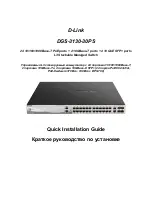
16
P
ORT
I
SOLATION
C
ONFIGURATION
Port Isolation
Overview
Introduction to Port
Isolation
The port isolation function enables you to isolate the ports to be controlled on Layer 2
by adding the ports to an isolation group, through which you can improve network
security and network in a more flexible way.
Currently, you can configure only one isolation group on a switch. The number of
Ethernet ports an isolation group can accommodate is not limited.
The port isolation function is independent of VLAN configuration.
Port Isolation and Port
Aggregation
When a member port of an aggregation group is added to an isolation group, the
other ports in the same aggregation group are added to the isolation group
automatically.
Port Isolation
Configuration
Table 63 lists the operations to add an Ethernet ports to an isolation group.
Displaying Port
Isolation
After the above configuration, you can execute the
display
command in any view to
display the information about the Ethernet ports added to the isolation group.
Port Isolation
Configuration
Example
Network requirements
■
PC 2, PC 3 and PC 4 are connected to GigabitEthernet1/0/2, GigabitEthernet1/0/3,
and GigabitEthernet1/0/4 ports.
■
The switch connects to the Internet through GigabitEthernet1/0/1 port.
■
It is desired that PC 2, PC 3 and PC 4 cannot communicate with each other.
Table 63
Configure port isolation
Operation
Command
Description
Enter system view
system-view
—
Enter Ethernet port
view
interface
interface-type
interface-num
—
Add the Ethernet port
to the isolation group
port isolate
Required
By default, an isolation group
contains no port.
Table 64
Display port isolation
Operation
Command
Display the information about the Ethernet
ports added to the isolation group.
display isolate port
Summary of Contents for 3CR17660-91
Page 10: ...8 CONTENTS ...
Page 14: ...4 ABOUT THIS GUIDE ...
Page 46: ...32 CHAPTER 5 LOGGING IN THROUGH WEB BASED NETWORK MANAGEMENT SYSTEM ...
Page 48: ...34 CHAPTER 6 LOGGING IN THROUGH NMS ...
Page 60: ...46 CHAPTER 9 VLAN CONFIGURATION ...
Page 64: ...50 CHAPTER 10 MANAGEMENT VLAN CONFIGURATION ...
Page 80: ...66 CHAPTER 13 GVRP CONFIGURATION ...
Page 98: ...84 CHAPTER 15 LINK AGGREGATION CONFIGURATION ...
Page 112: ...98 CHAPTER 18 MAC ADDRESS TABLE MANAGEMENT ...
Page 126: ...112 CHAPTER 19 LOGGING IN THROUGH TELNET ...
Page 162: ...148 CHAPTER 20 MSTP CONFIGURATION ...
Page 274: ...260 CHAPTER 29 IGMP SNOOPING CONFIGURATION ...
Page 276: ...262 CHAPTER 30 ROUTING PORT JOIN TO MULTICAST GROUP CONFIGURATION ...
Page 298: ...284 CHAPTER 33 SNMP CONFIGURATION ...
Page 304: ...290 CHAPTER 34 RMON CONFIGURATION ...
Page 338: ...324 CHAPTER 36 SSH TERMINAL SERVICES ...
Page 356: ...342 CHAPTER 38 FTP AND TFTP CONFIGURATION ...
Page 365: ...Information Center Configuration Example 351 S4200G terminal logging ...
Page 366: ...352 CHAPTER 39 INFORMATION CENTER ...
Page 378: ...364 CHAPTER 40 BOOTROM AND HOST SOFTWARE LOADING ...
Page 384: ...370 CHAPTER 41 Basic System Configuration and Debugging ...
Page 388: ...374 CHAPTER 43 NETWORK CONNECTIVITY TEST ...
Page 406: ...392 CHAPTER 45 CONFIGURATION OF NEWLY ADDED CLUSTER FUNCTIONS ...
















































